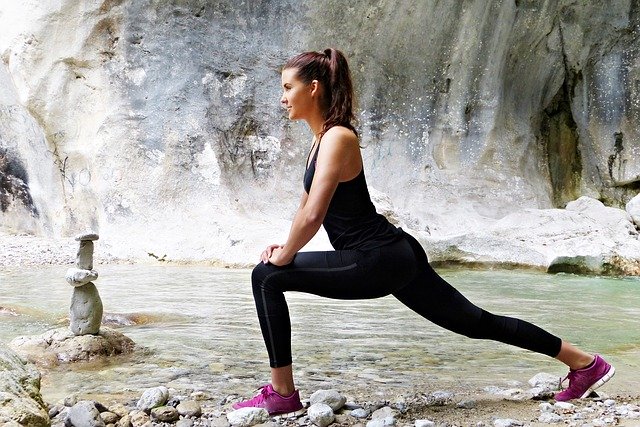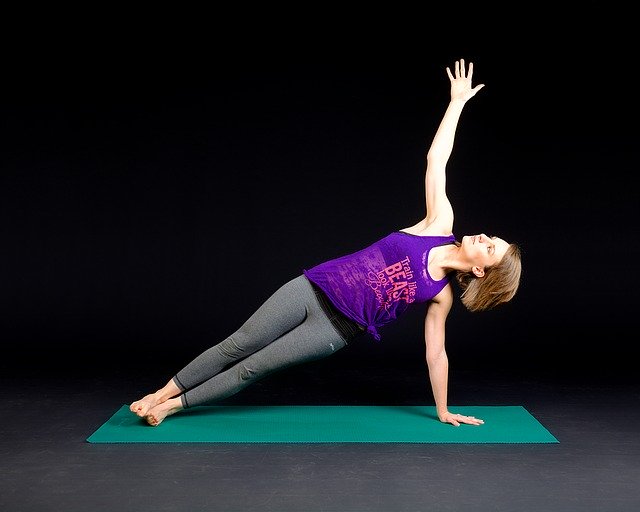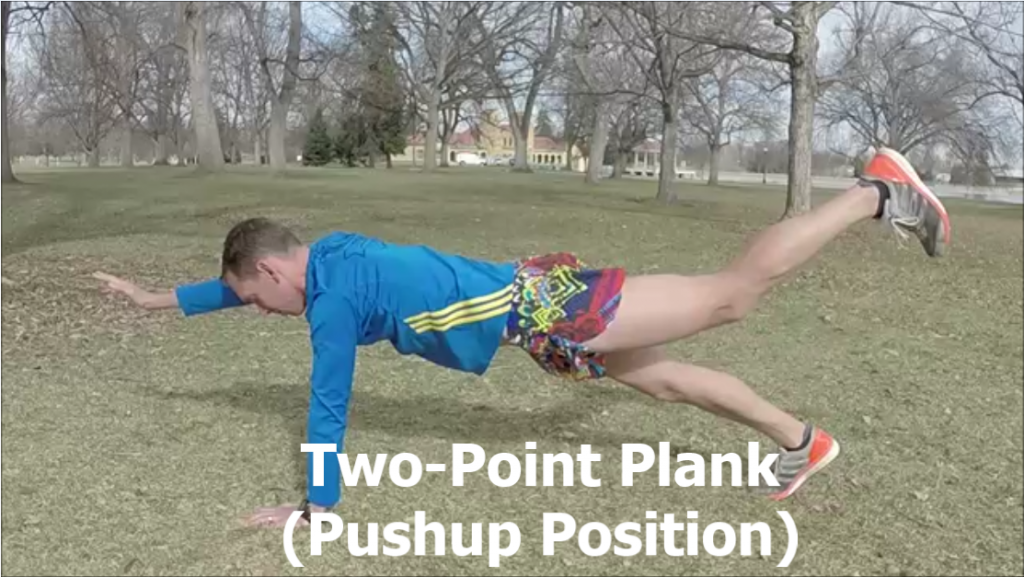Strength training is not cross-training for runners. It’s just part of the training that’s needed to properly prepare for a peak performance.

And while ideal strength training will consist of weightlifting in the gym – lifting for power and strength – what if you don’t have the option of going to a gym?
You might…
- Not have a gym conveniently located near you
- Be unable to afford a gym membership
- Have no interest lifting weights in short shorts (I respectfully disagree)
- Be sheltering at home through a once-in-a-century global pandemic
So if a gym membership isn’t possible – and you don’t have a well-stocked home gym – then we have to rely on a bodyweight exercise routine.
That’s not necessarily a bad thing as we can gain a lot of strength, injury prevention benefits, and form improvements from bodyweight exercises. We just need to ensure that our strength workouts are structured appropriately.
That structure depends on your fitness level and the goal.
So if you haven’t started a strength habit yet, this article will help you build your own bodyweight exercise routine (or, use one of our existing routines).
If you’re like my past client Sarah, you’ll notice the difference quickly:
If it were not for you I would not have realized the additional work that should be done. I’m looking forward to this training cycle and so are my hips, glutes, hamstrings and IT Bands :)! Your workouts are such an inspiration. – Sarah
But first, we need to establish the goal.
Step 1: What’s the Goal of the Bodyweight Exercise Routine?

This will help you determine what exercises to include in the routine, its length, and how it’s structured overall.
While there can be many goals of a set of bodyweight exercises like weight loss, general fitness, or “getting ripped” us runners are usually more specific. Because we’re athletes, our goals have more to do with performance.
That means our strength training can have a few types of goals:
- Stability
- Strength / Power
- Cardiovascular / Metabolic / Aerobic
Stability is a type of strength that helps you maintain good form when you’re fatigued or covering technical terrain on the trails. It’s also an important skill for injury prevention. Exercises for this goal will have a few characteristics:
- They’ll have no resistance (from a medicine ball, exercise band, dumbbell, etc.)
- Focused on the core rather than on the upper body or legs
- They’ll typically be slightly easier than “strength” exercises (or, performed slightly differently)
Strength and power help you kick harder at the end of races, build better muscle coordination, and improve your running economy. Exercises for this goal have these characteristics:
- Extra weight is added (whether a formal implement like a med ball or a paint can, child, or a jug of water)
- They’re focused on the major muscle groups (instead of a supporting exercise like a clamshell that targets the glute medius)
- They’ll be slightly more advanced or performed differently
Cardiovascular or metabolic fitness is what we runners typically get from running. I normally advise against this goal for our strength training but I’m making an exception today.
If you’re stuck at home without any equipment, maintaining your aerobic fitness can be accomplished partially through a bodyweight exercise routine. We’ll need high-intensity exercises and very little rest to maintain a higher heart rate.
Now, it’s important to note that these goals do not exist in isolation from each other. If you exclusively train for stability you’ll still gain strength and some aerobic benefits – and vice versa.
Just like you can still get faster if you only run slow, you can still develop some power if you don’t do any power exercises.
The benefits of training accrue at different rates depending on what activity you’re doing. Our goal is to make sure that our workouts are focused.
Step 2: Choose Exercises

From our plank routine – the Gauntlet Workout
Once you understand the goal of the routine – stability, strength/power, or metabolic fitness – then you can start choosing exercises.
While there are hundreds (thousands?) of bodyweight exercises to choose from, it’s typically best to focus on the fundamentals. They’re easier to learn and more effective. After all, they’re the fundamentals for a reason.
Choose exercises like:
- Squats (and squat variations)
- Planks (and plank variations)
- Deadlifts
- Pushups
- Glute bridges
- Lunges
- Pull-ups / Chin-ups
- Bird dogs
- Hip thrusts
- Overhead press
Almost all of these exercises are helpful for building stability and strength. But we’ll need additional exercises for cardiovascular development, like:
- Split lunge jumps
- Burpees
- Jumping jacks
- Jump rope
- Mountain climbers
These exercises, far more than the options in the first list, will increase your heart rate and provide a stronger metabolic stimulus.
Step 3: Determine the Order, Recovery, & Sets
View this post on Instagram
Staying fit while sheltering at home 💪🏻👍🏻😉
A post shared by Jason Fitzgerald (@jasonfitz1) on
Once we understand the goal of the routine and have a series of exercises picked out, it’s time to structure the routine.
The order of exercises, how much recovery is given after each exercise, and the number of sets all determine the type of workout you’re about to get.
Every routine should be structured as general to specific. That means runners will progress from exercises done on the floor in a seated position to exercises done while standing.
Every routine should also be set up to go from simple to complex. That means runners will progress from easier exercises to the more difficult exercises.
If the goal of the workout is cardiovascular fitness, recovery between exercises and sets should be kept to a minimum (or none at all!). This will help keep heart rate elevated throughout the workout. Bodyweight exercise routines with a strength or stability focus can include more recovery.
The number of sets in the routine helps determine its difficulty. Beginners can do 1-2 sets while more advanced athletes can build up to 3-4 sets.
Now you know the goal of the routine, what exercises you’re going to choose, and how the session will be structured.
Let’s review a few example workouts so you fully understand how to create a bodyweight exercise routine.
Example Bodyweight Exercise Routine for Stability
To show the incredible variety that we can expose ourselves to, runners can train for stability using a single exercise or a series of different exercises.
The Gauntlet Plank Workout uses 11 different plank variations to build dynamic core stability:
It includes:
- Pushup plank
- Side arm raise (in pushup position)
- Front arm raise (in pushup position)
- Forearm plank
- Pushup plank shuffle
- Forearm to pushup plank
- Spiderman plank
- Alternating leg lifts (pushup position)
- Two-point pushup plank
- Alternating leg lifts (forearm position)
- Two-point forearm plank
You can also download a photo guide to this routine here (I’ll also send you our other photo guides!).
If you prefer a wider variety of exercises (I certainly do) then you’ll love the Standard Core Routine:
It includes:
- Modified bicycle
- Plank
- Bridge
- Side plank
- Modified bird dog
- Supine leg lift
This is my “bread and butter” core workout for runners that trains everything from the glutes, hips, obliques, abs, and hamstrings. If you’re able to do three sets of this routine three times per week, you’ll thrive.
Example Routine for Strength
Building strength is far easier when we’re lifting extra weight. And most of us have access to simple tools like:
- Medicine ball
- Kettlebell or an adjustable dumbbell
- Exercise band
- Jug of water, child, tire, piece of wood, paint can, etc.
So if you can add weight to an exercise, you can safely consider it a more “strength-oriented” exercise.
But you don’t necessarily need a weighted implement. You can perform the eccentric contraction of any lift slower and more deliberately than the concentric contraction to make it far more difficult. This is called a “negative rep” and it helps to put the muscle under more stress.
If you’re doing a squat, the downward squat is the eccentric contraction – this is when the quadriceps is lengthening but still under load. To perform a negative squat, just squat down slowly and then stand up to the starting position at normal speed.
You can also incorporate both negative reps and weighted reps into any bodyweight exercise routine to make it more challenging.
An effective strength workout for runners is the Tomahawk Medicine Ball Workout:
It includes:
- Plank (rotation optional)
- Rocky solo
- V-up
- Hot salsa
- Single-leg deadlift with press
- Twisting lunge
- Haybale
All you need is a medicine ball and enough overhead space to lift it above your head (so… I can’t do this exercise routine in my basement…).
Example Routine for Metabolic Fitness
But what if you can’t run or do any other aerobic exercise like pool running, swimming, cycling, or the elliptical?
If you’re sheltering at home or quarantined like one of my clients, you’re left with very few options. After all, it’s hard to maintain your cardiovascular fitness if you can’t do any cardio.
But if we use high-intensity bodyweight exercises with little recovery, we can raise our heart rate and stimulate our metabolic fitness without ever running a step.
MetCon Alpha uses a variety of exercises in a HIIT format:
The exercises in this workout include:
- Warm-up: 2-3 running form drills
- Burpees
- Spiderman Plank
- Pushup with mountain climbers
- Side plank with leg raises & “thread the needle”
- Split lunge jumps
This is a very flexible routine; the number of repetitions and recovery can both be manipulated to make it easier or more challenging.
Get All of Our Best Bodyweight Exercise Routines
Since 2010, Strength Running has developed a variety of core, strength, and dynamic warm-up routines to help runners get stronger, stay healthy, and prevent their next running injury.
And I want you to have all of them.
Sign up here for the Gauntlet Plank Workout PDF guide – a photo version of the routine so you won’t have to watch the video every time.
In addition to the Gauntlet Workout, I’ll also include the rest of our best workouts:
- Standard Core Routine (photo version)
- Standard Warm-up
- ITB Rehab Routine
- Tomahawk Medicine Ball Workout
- Mattock Warm-up Routine
If you’re stronger, adequately warmed up, and have the stability to withstand the rigors of running then you’ll undoubtedly be a better athlete.
Get started here with our best bodyweight exercise routines!